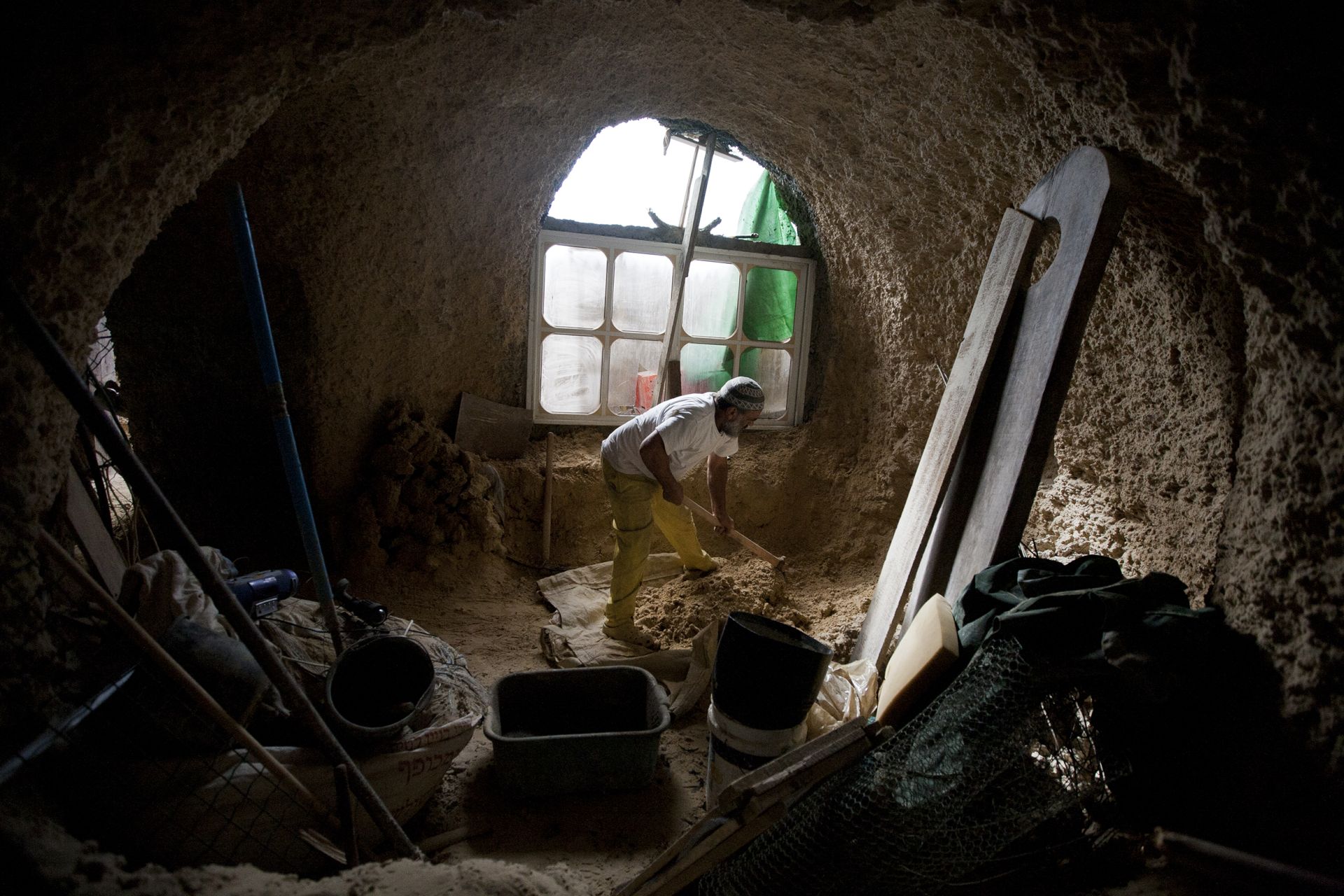“Spotlight” is a newsletter about underreported cultural trends and news from around the world, emailed to subscribers twice a week. Sign up here.
Ten miles north of Tel Aviv, inside a sandstone cliff on the Mediterranean Sea, there is a dwelling that goes by several names: “The House of Shells,” “The Hermit House” or, simply, as a small sign declares, “Nissim’s House.” It is, to all outward appearances, unlike anything else in Israel — or, for that matter, in the world.
The structure’s facade rises from the sandy shoreline all the way up the steep cliff, in different levels and flourishes: here a wall made of sea rocks and shells, there glass bottles shimmering in the sun, beams of driftwood and curved stone arches, actual windows and doors and balconies peeking out from various crevices. It is less a home and more a work of art, as the technicolor mosaics and oddly carved faces attest. (And all this before you even step inside.)
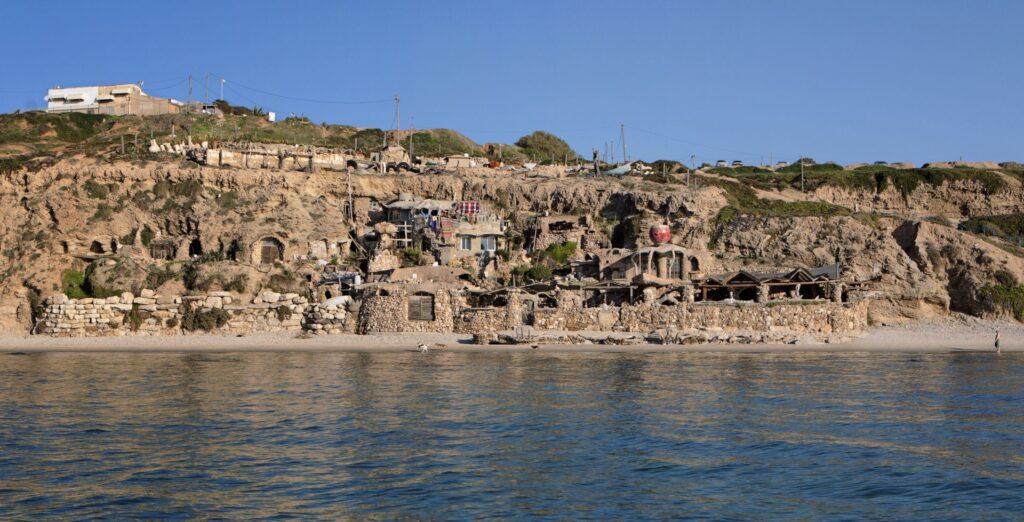
But someone does live here: the eponymous Nissim Kahlon, 77, who first took chisel to sandstone nearly five decades ago, digging the first small cave of what would become a sprawling life’s work.
Now, the Israeli authorities are threatening to evict Kahlon and demolish his home, stating that he squatted and built illegally on public land, and alleging that the structure is an environmental hazard and prone to collapse. Kahlon freely admits the first charge but waves away the rest.
“I worked here fifty years with no salary. What did I do — did I murder, steal, rape? No! This house is a museum. They should give me a prize,” he told New Lines during an in-person interview at the house. “Everyone, including tourists, come here and are in shock. ‘This is unbelievable,’ they say. … I never claimed this was my property but I built something here that is of value to the public.”
His neighbors, local municipal officials and a small group of supporters appear to agree, pushing for Nissim’s house to be declared a national heritage or even a UNESCO World Heritage Site. The authorities, led by the Ministry of Environmental Protection, insist the house must be sealed and destroyed. Nissim’s fate, and that of his longtime home, will be decided by the courts.
For some, it’s simply a referendum on a unique structure that should be preserved; for others, a case of hypocritical enforcement by the Israeli government against an aged and politically powerless man. But more than anything, the case is a meditation on modernity itself, and how one person, for decades, decided to refrain from playing the game.
Nissim Kahlon first arrived in the tiny coastal town of Herzliya Pituach, one of Israel’s wealthiest enclaves, in the early 1970s. He was 29 and several years removed from his mandatory military service. As he tells it, he was running away from an arranged marriage and an itinerant existence in the dusty central Israeli town where he grew up among 11 other siblings, the sons and daughters of poor immigrant parents from Libya.
He initially pitched a tent on the beach down the coast from his current home, but the police came and made him leave. Wandering north, he came upon a fisher’s cove but, after a day, decided to simply begin digging his own shelter inside a nearby cliff face in the Nof Yam neighborhood, on the Sidna Ali Beach (so named for the 15th-century Mamluk-era mosque that still exists at the top of the ridge, surveying the azure waters below).
This 5-square-meter cave, with a little cot and some candles, was how things began. It would only grow from there, as Nissim, with rudimentary tools and, as he puts it, “my own two hands and shoulders and back,” began expanding: more caves and interlocking passageways, usually chiseled with a self-fashioned iron spear to break the rocks, as well as shovels and spatulas to further the work. At one point, he created a dinosaur that stood as part of the structure, with the curved cave roofs making up the body and the head and tail fashioned out of iron and plaster. In 1984, the Herzliya mayor hooked him up to electricity and water and gave him a postal address. A large wooden deck was built on the shoreline and, after that, a cafe which, into the early 1990s, served beachgoers cold beer, ice cream and fresh fish.
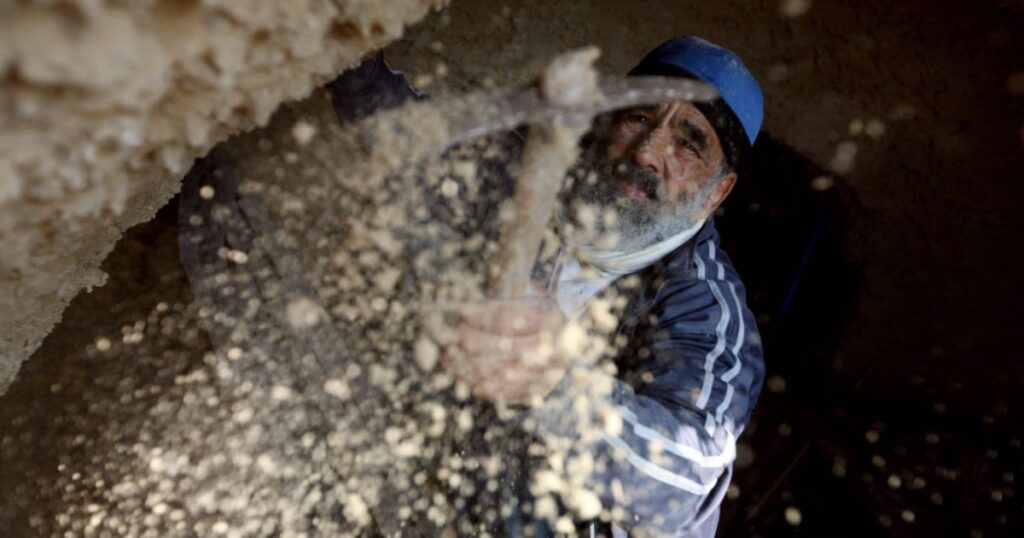
There was no real master plan or end point for the home. Nissim had no background in engineering, architecture or even art; he was a true autodidact — some would even say genius — deploying an Israeli version of vernacular architecture. He simply went by feel, and trial and error.
“If I make a mistake, I fix it,” he tells me, like the dinosaur tail and head that corroded and fell apart. (Iron, it turns out, doesn’t hold in the salty air, which is why he now uses plastic pipes.) The materials were almost always recycled or reappropriated, basically anything that came to hand: shells and stones from the beach, driftwood, discarded plastic tubes, glass beer bottles, furniture left on the street. The list was, and remains, endless.
He did have helpers over the decades who worked alongside him, curiosity seekers and other wandering souls. “Some stayed for one hour, others for 20 years,” says Ori Hillel, a close (young) friend of Kahlon’s and a distant relative. “It all depended on how much Nissim liked them. They came from all over the world — Germany, Japan, America, etc. — and lived there with him.”
It may be known as the “Hermit House,” but Nissim wasn’t always a hermit. He’s been married (and divorced) twice and has a daughter and two sons, one by an American woman he met in Chicago while on a month-long trip. He ended up staying in Chicago for several years in the late 1970s and into the mid-1980s, while a friend minded the homestead back in Israel.
As an old photo album Nissim looks over attests, there were periods — seemingly happy periods — filled with family and friends: a younger Nissim, his hair and bushy beard still jet black, raising a glass with a group at his cafe, hugging a younger blonde woman, looking at a beautiful sunset.
And yet there is likely something to the “hermit” sobriquet, similar to the “caveman” nickname that has stuck with him for years. “The stigma of the old man, isolated and grumpy is true,” Hillel says. “He’s a hard man who is often difficult to get along with.”
This dynamic was beautifully yet agonizingly rendered in a 2014 documentary about Nissim and his complex relationship with his son Moshe, called “Apollonian Story.” (The area is also known as Apollonia and dates back to the Phoenician period, with a Crusader-era fortress and national park excavated and opened to the public above Nissim’s home in the late 1990s.)
Likely not helping matters was a police raid about 30 years ago, during which Nissim claims a large sum of money was stolen from him. After a few nights in detention, he was freed and returned home — but he had learned his lesson.
“I made a mistake. I worked on the Sabbath,” he says now, referring to his cafe, which had remained open on the Jewish day of rest. “God punished me. From that point on I started from zero.”
The cafe was shuttered and, at 46, Nissim found religion. These days, with his beard a Santa-esque bushy white, and his head covered in a yarmulke, he is resolutely devout: waking up every morning to strap on the obligatory phylacteries, praying three times a day and peppering every other sentence with “blessed be his name.”
But the construction continued.
You don’t simply walk into “Nissim’s House” but, rather, into different parts of his house — caves, rooms, apartments, patios, likely a few dozen total — inside the overall compound. Stone steps and handles lead you on a path of exploration from one level to the next. Lamps have been embedded into the rock walls, where dark tunnels take you down through another opening. You may want to hold on to carved stone handles for safety.
In this way, you find a hollowed-out cave with various antechambers, some still sporting the rough-hewn rock of the original sandstone cliff; others smoothed-over plaster. On another level, beyond the colorful mosaics and clay pottery, is a fully equipped apartment with a large painted mural above a bed, a small kitchenette and bathroom, and windows looking out at the sea below. Green beer bottles have been used to decorate the ceiling and walls. Nissim sporadically rents the place out to guests.
In between, on yet another level, are Nissim’s living quarters: more compact and homely, filled with pictures of long-dead Jewish sages and religious texts, but with exits to a larger patio. Wind chimes on the balcony bang softly against the sea breeze, above a green guardrail with a Star of David built into it. Several small Israeli flags flutter in the wind.
Nissim’s actual home within his home is, similar to the man, both utilitarian and ornate, sparse yet cluttered.
Clay mosaics in all colors cover the floors and walls and even the kitchen countertop. Like the entire house, there are no straight lines — only curves. A simple wood-burning stove and chimney provide warmth during the rainy winters; a black tarp over the patio provides cover during the harsh summers. Tools are left here and there. Down the hall (again, a dark rock tunnel) you find a fully functional bathroom and shower.
But more than anything, there is the ever-present Mediterranean and the metrical sound of the waves crashing below — as if Nissim’s House were a conch shell, shipwreck and sandcastle magically deposited on the shore of the richest coastline in Israel. The nearby mansions have only gotten bigger and more expensive in the intervening years. The beachfront residence of the U.S. ambassador was sold a few years ago, in the twilight of the Trump presidency, for nearly $70 million.
Nissim speaks gruffly and in sporadic bursts, a rolled-up cigarette of unclear provenance always near his mouth. His responses are well worn and rehearsed, probably due to a lifetime of answering the same questions from bewildered visitors: Who are you, how did you build all this, when did you start, and why?
Yet the recent news has hit Nissim hard. Friends attest that he’s depressed and in pain, and not just due to a recent hip surgery and the need to move around with the help of a walker.
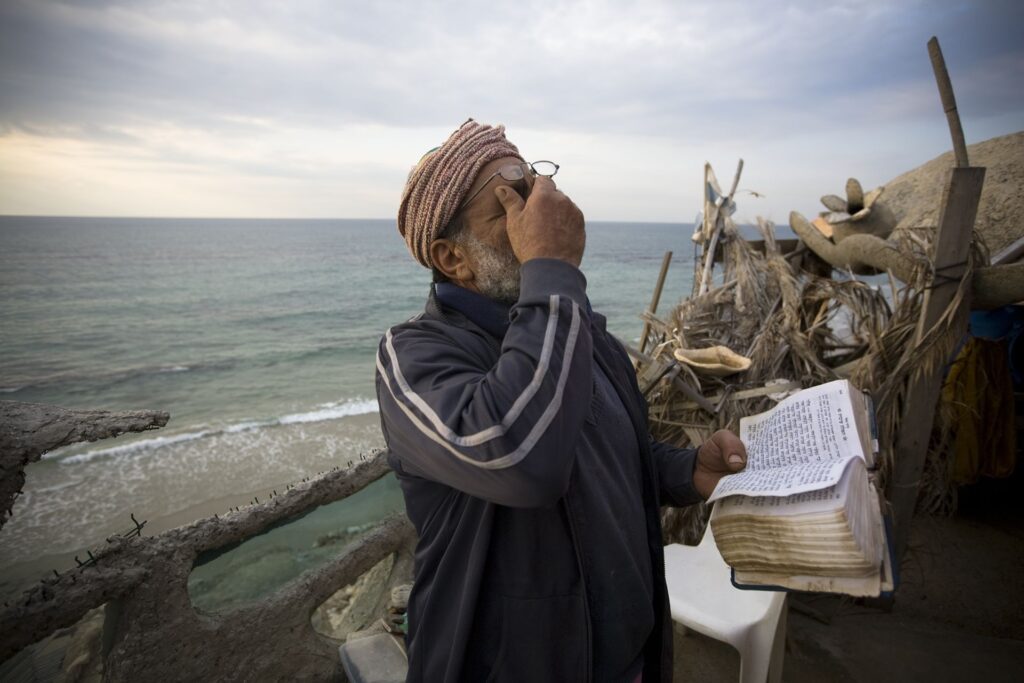
Last summer, the Ministry of Environmental Protection began proceedings against him that dragged on until last month, when an eviction order was issued. “The multitude of environmental offenses that occur as a result of the complex are unprecedented and we are putting an end to it,” one ministry official told a local newspaper.
Nissim is withering in his anger at the ministry, which he dismisses as “those Greens.”
“They’ve never built anything in their lives,” Nissim thunders. “They teach all the time about recycling. This is all recycled materials that I use. Nothing goes to waste … there’s no such thing as garbage, I use everything.”
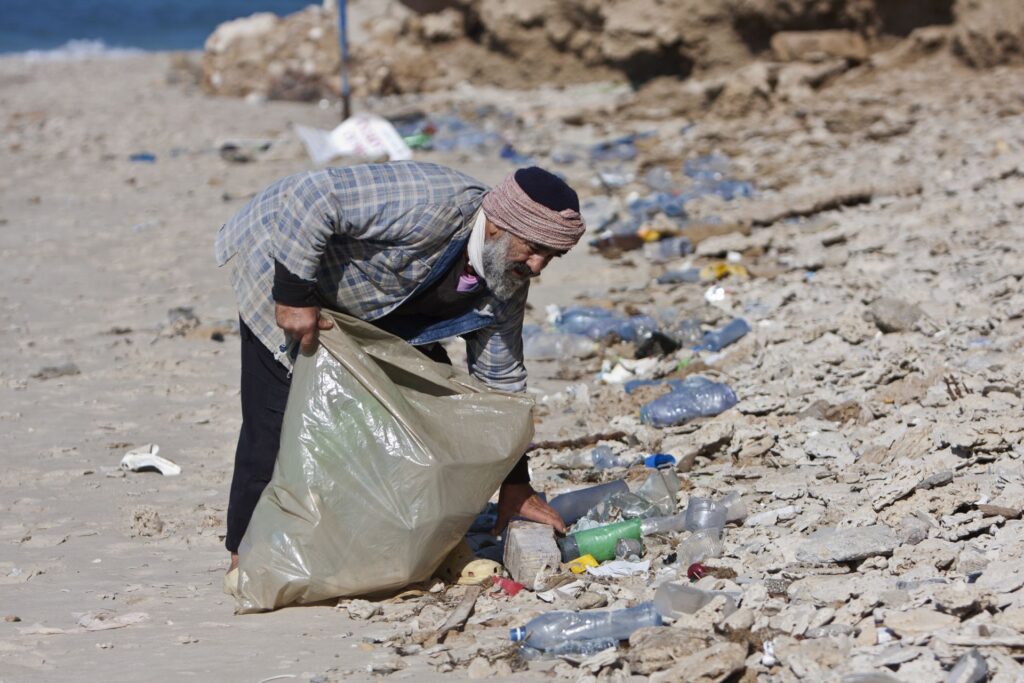
More to the point, Nissim says that the real ecological damage wrought to the area was done farther south by the construction two decades ago of a swanky marina, replete with luxury yachts, shopping centers and a Ritz-Carlton hotel. The changes in tide patterns began whittling away at the Sidna Ali Beach, an assertion longtime locals confirm. A formerly wide and sandy shoreline is now nearly flush against Nissim’s front wall.
“The sea used to smell like fish, we had fish here. Now it smells like soap and oil,” Nissim says with sadness. The fisher’s cove is long gone, as are most of the beachgoers.
The contention by the ministry that Nissim’s House is in danger of collapse may have more validity, yet the sheer longevity of the place works against this argument — as does an explosion in 1992 at a nearby Israeli military ammunition factory which was heard for miles up and down the coast. Nissim’s House was untouched and stood strong, while the factory was evacuated a few years later. The cleanup of hazardous groundwater is still ongoing.
“He’s been here for many years,” a local television reporter said, pressing the same environmental ministry official, almost pleading with him to let the old man stay by the sea.
“Why not that person or that person, why not you, why him?” the official shot back. “Breaking the law for many years doesn’t give you legal immunity for anything.”
This argument, more than all the others, is perhaps the most galling. Take even a cursory look at the illegal construction going on across Israel, especially in West Bank settlements, and the lesson is clear: Many segments of Israeli society, given the right political backing, have indeed received immunity.
“He should have built his caves in the Judean Desert [in the West Bank],” one friend who heard Nissim’s story quipped.
For now, an eviction order that had been set for this past weekend was stayed by the courts for a few weeks. With the help of his siblings, Nissim was able to raise money to hire a lawyer who will attempt to fight the authorities in court. An online crowdfunding effort and even an auction of items and artwork from the house are being planned, in order to cover his legal bills.
“Our work now is political, to raise the media volume,” says Ori Hillel. “We have to persuade people that there is something here that should be invested in, and that it can be transformed into a tourist site.”
Nissim feigns indifference regarding the fate of his life’s project after he’s gone, but those who know him say it would destroy his soul to see it lost.
“If they had come to me 30 or 40 years ago and said you’re illegal, leave, I would have left — but now where do I have to go?” Nissim says. “I can’t even walk. How much longer do I have?”
The years of hard labor have caught up with Nissim, but the joy that his house brings to people who see it for the first time remains. In an age and country where everything is now commodified and tagged with a shekel price, where swaths of nature and beachfront are given over to developers, where people yearn for even a fleeting hint of authenticity, there is Nissim Kahlon and the home he built himself, still defying all modern logic, still standing in the most beautiful spot in Israel.
“I’m not leaving here until I die, they can entomb me inside if they want,” he says, as visitors and this reporter begin leaving to let him rest. He shuffles over with the walker to a small alcove he only recently began digging on the side of his balcony. It looks, for all the world, like an actual tomb. He plops himself onto a cushion and lies down, leg crossed, to nap in the sea breeze.
Sign up to our mailing list to receive our stories in your inbox.



